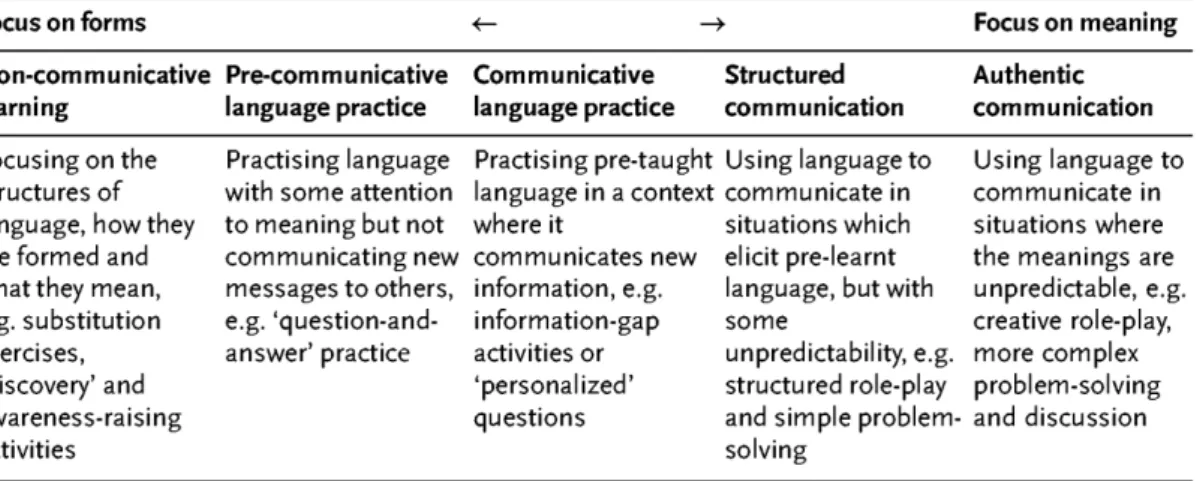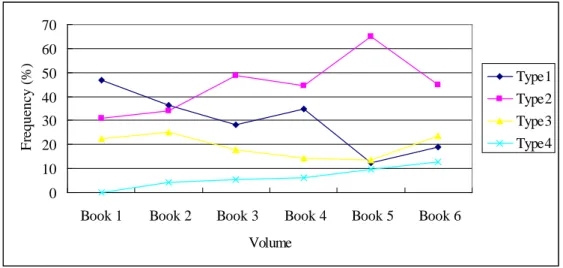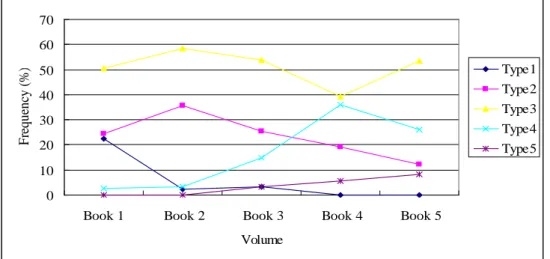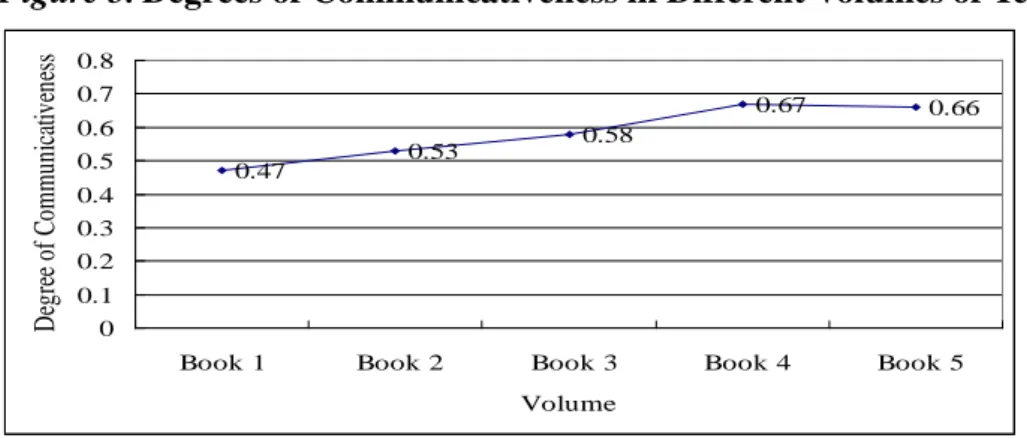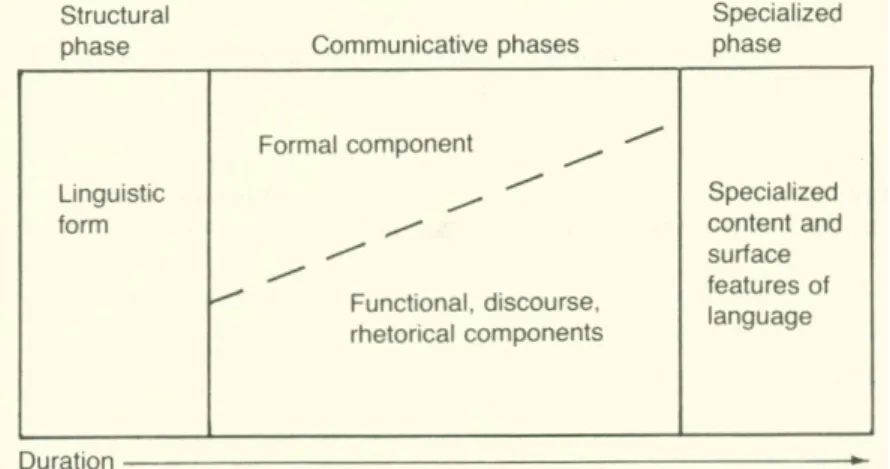144
An Analysis of Speaking Activity Designs of Junior-High-School
English Textbooks Used in Taiwan and China
Yuanching Lee (李元慶) and Lihung Chang (張理宏) National Pingtung Universiy of Education
ABSTRACT
The purpose of this study is to explore the designs of speaking activities used in Taiwanese and Chinese junior-high-school English textbooks. The present study was carried out using content analysis. Three raters participated in this study and two textbook series were selected to analyze. The finding are as follows: (1) the speaking activities in these two junior high-school English textbooks lack an adequate level of opportunity for authentic communication; (2) a predominance of information-gap activities is found in textbooks C, and it is found that almost three-fourths of the speaking activities of textbooks T are drills; (3) the degrees of communicativeness of the two textbook sets basically conform to the common progression; that is, form-focused activities are gradually de-emphasized, and meaning-focused activities are given more emphasis as learners’ proficiency levels increase; (4) the design of pronunciation teaching is quite different between the two sets of textbooks. The textbooks T series covers pronunciation teaching including a look at segmental and suprasegmental levels; however, in textbooks C, no suprasegmental features are introduced, and only Book 1 presents pronunciation teaching. The results reveal two reminders for textbooks teachers and one for publishers: (1) it is feasible to get novice students involved in using language in a more meaningful context, even though they are still beginners; (2) the teacher can take advantage of his or her position to do something that textbooks cannot. With the teacher’s work and encouragement, many speaking activities could become more communicative; (3) the textbooks publishers should create more communicative communication activities to support their claims, in which their designs of textbooks are based on communicative approach.
Key words: English textbooks, communicativeness, speaking-activity design, communicative approach, textbook analysis, communicative language teaching.
INTRODUCTION
145
Foreign Language (EFL) learning has emerged. “English has become the world’s second language, the world’s lingua franca” (Krashen, 2006, p. 1).
In consideration of the growing importance of English, the Taiwanese government has paid much attention to English education in order to help its people keep up. In the past quarter century, English education has inevitably been influenced by the growing prevalence of communicative language teaching. This pervasive teaching approach uses syllabi and textbooks designed with a main focus on communication as opposed to linguistic form. Nevertheless, the fact remains that learners do not have enough opportunities to practice speaking English in daily life because of the EFL situation in which Taiwanese learners learn. Since it is difficult for learners to get enough practice engaging in verbal communication with native English-speaking interlocutors, the teaching methods employed in classrooms and the way English speaking material is organized and conceived in textbooks will be vital to improving the speaking competence of learners. “A textbook is an important means of satisfying the range of needs that emerge from the classroom,” and textbooks are a universal element in English language teaching (Hutchinson & Torres, 1994, p. 327).
In Taiwan, most English textbooks claim that students will be able to communicate in English after three years of study in junior high school. These claims assume that communication-oriented speaking activities can help students acquire English speaking competence. Yet Ellis (1982) asserted that “the vast majority of self-labelled ‘communicative’ courses do not adopt a truly ‘communicative approach’”(p. 77).
What kinds of activities should be included in English textbooks if they aim to develop students’ speaking abilities? Grant (1987) states that a good textbook should include three types of speech work.
1. Drills, which help students to develop language accuracy. Drills are usually mechanical exercises that help students facilitate the process of learning the sounds and grammar of the language. Drills are not meaningful exercises; however, they are useful for helping novice learners master some of the basic structures of a language.
146
3. The use of natural and spontaneous language, which is something that some textbooks endeavor to cover, but only the teacher can really instill, since the teacher can interact with students or encourage them to interact with each other in a way that the textbook cannot.
Classification of Learning Activity
Littlewood (2004) outlined a framework to classify language-learning activities into five types: non-communicative learning, pre-communicative language practice, communicative language practice, structured communication, and authentic communication.
Non-communicative learning involves the strongest emphasis on form. The activities are usually uncontextualized, and learners’ responses are always fixed. Therefore, even if learners do not understand the meaning of the question or stimulus, they can respond in the right way. This category therefore includes (e.g.) substitution drills, uncontextualized grammar exercises, and pronunciation drills.
Pre-communicative language practice still emphasizes mainly structural features, but also moves towards meaning. There is still control over learner’s responses, but there may be more than one correct way for learners to respond. Teachers should always know what learners are going to say because there will be no new information here. One familiar example is question-and-answer practice, in which a teacher asks a question to learners and it’s necessary for the learners to pay attention to the meaning of the words if they want to respond correctly.
Littlewood’s third category is communicative language practice, in which the range of language use is still predictable and learners use the predictable language to convey information. There is still some control over learners’ responses, especially in syntactic patterns, but no control over lexical items. Since there is no control of lexical items, learners can add new information and respond in different ways in different real-world situations. For example, this category includes activities in which learners use recently learned vocabulary and structures to do a survey, or where they use learned sentence patterns to get some information from their partners in order to complete a task. A classic example of communicative language practice is an information-gap activity.
147
Last, at the extreme right of the diagram, is authentic communication. The most obvious feature of authentic communication is its strong focus on the communication of a message. In authentic communication, language forms employed are absolutely unpredictable, such as using language to discuss, to solve a problem, or to complete a content-based task.
To sum up, non-communicative learning and pre-communicative language practice mainly focus on linguistic forms; communicative language practice is a transition from drills to communication; structured communication is comparatively meaningful; and authentic communication puts all emphasis on communicative function. The five types of learning activities are illustrated below:
Figure 1. The continuum from focus on form to focus on meaning (Littlewood,
2004, p. 322)
The Sequence of Learning Activities
As for the sequence of activities, Yalden (1989) explained that linguistic forms and communicative functions are complementary, and both are necessary for designing courses in a way that helps develop communicative competence. The proportion of each should be arranged differently throughout a course. At the beginning of the course, learning of linguistic forms should be given more emphasis, and then be de-emphasized gradually. In contrast, learning of communicative functions should be given more emphasis as learners’ language proficiency progresses toward more advanced levels.
148
for them. Hence, within a teaching unit, there is no fixed sequence of learning activities.
In 1999, the Ministry of Education ended its textbook monopoly, subsequently authorizing private publishers to design new versions of textbooks according to the Nine-Year Curriculum Guidelines. With the proliferation of new English textbooks, numerous recent studies have investigated these texts. In addition to our own textbooks in Taiwan, we must realize how English textbooks are designed in other Asian countries. Across the Taiwan Strait, fast-developing China merits study, because Taiwan and China share numerous similarities in culture and language. Although a large amount of effort has been made to improve English textbooks in Taiwan, what appears to be lacking so far is a comparative study looking at both Taiwan and China. For the aforementioned reasons, a clearer understanding of English textbooks in the two countries is in urgent demand.
Research Questions
Based on the lack of previous examinations of similarities and differences in junior high-school English textbooks between Taiwan and China, the purpose of this study is to explore a little further the state of junior high-school English textbooks in the two countries. Here, the discussion will be limited to speaking activities contained within the books, since the matter of primary consideration is the book’s utility in supporting and developing the learner’s speaking ability. The research questions examined in the current study are as follows:
1. What are the major types of speaking activities included in Taiwanese and Chinese English textbooks?
2. Are there similarities and differences between English textbooks in the two countries?
3. To what degree do the speaking activities of Taiwanese and Chinese junior high-school English textbooks foster real-world verbal communication skills?
METHODOLOGY Content Analysis
The present study was conducted using content analysis. Content analysis is a systematic, objective technique for summarizing texts into content categories based on explicit rules of coding (Krippendorff, 2004; Weber, 1990). Babbie (2008) elaborated on this description of content analysis as follows:
149
on the Internet, laws, and constitutions, as well as any components or collections thereof (p. 350).
Under the above definition, the technique of content analysis can be applied to wide areas. Both the textbooks examined and the student speech productions in the present study would be appropriately analyzed with content analysis. Therefore, the present study was carried out using content analysis to explore the speaking-activity design of Taiwanese and Chinese junior high-school English textbooks.
Textbook Selection
Textbook set T was chosen to represent Taiwanese textbooks for two main reasons. For one thing, one of the authors has used textbooks T in his own teaching. The other reason is that textbooks T were the most-recommended junior high-school English textbooks. In 2010, textbooks T were voted the best English textbook series by junior high schools in Taipei City, Taipei County, and Keelung County (Department of Education, Taipei City Government, 2010). Because textbooks T were identified as the best by majority ballot, it is believed that these officially suggested textbooks can be regarded as representative of textbooks in general.
As for China, textbooks C are chosen for two reasons. First, they were designed by the People’s Education Press and Thomson Learning. In China, textbooks published by People’s Education Press account for 50% of the textbooks market (Chang, 2008). This is because the People’s Education Press is directly subordinate to the Ministry of Education of the People’s Republic of China. Second, Wen (2005) indicated that the textbooks C had control of approximately 70% of the junior high-school English textbook market.
Coding Units for Analysis
150 TABLE 1
Total Number of Speaking Activities
Book Textbook T Textbook C
1 94 111 2 91 87 3 74 95 4 83 89 5 74 131 6 47 Sum 463 513 Coding System
Littlewood’s (2004) classification is adapted as the criteria because there are five activity types in Littlewood’s classification and the criteria for examination of activities are based on the communicative potential of those activities. The purpose of the present study is to look into types of speaking activities as well as their “communicative degrees.” The focus of Littlewood’s classification is levels of communicativeness, which fits in with the purpose of this study.
Littlewood divided activities into five types: non-communicative learning, pre-communicative language practice, communicative language practice, structured communication, and authentic communication. These five types are classified according to gradual decrease of rote response and increase of communicativeness. The following is a summary of the criteria adopted in this study.
TABLE 2
Criteria for Classifying Activities (Adapted from Littlewood, 2004)
Task types Criteria 1. Non-communicative learning
1-1. There is a strong focus on language form.
1-2. There is total constraint on learners’ responses.
2. Pre-communicative language practice
2-1. There is no new information.
151
ways. 3. Communicative language practice
3-1. There is still some constraint over learners’ responses, especially in syntactic patterns, but no constraint over lexical items.
3-2. Learners can add new information. 4. Structured communication
4-1. The syntactic patterns and lexical items used by students are not restricted.
4-2. (原本有 However)The teacher has structured the situation to help students deal with communication. 5. Authentic communication
5-1. There is the strongest level of focus on communication of messages. 5-2. Language forms used by students are
unpredictable.
Data Analysis
Speaking activities in the textbooks were coded by all three raters. Two raters were qualified junior high school English teachers with more than three years of experience, and the other one rater was one of the researchers. The process of coding was based on coding procedures and coding criteria. The next two sections will show how the activities were coded and how the data was displayed.
Types of Activities in the Light of Communicativeness
152
Scoring of Communicativeness
To compare the communicativeness of speaking activities in the two sets of textbooks, Littlewood’s classification system is transformed into a scoring system. The activities in type one (non-communicative learning) received one point, since they are the least communicative. In contrast, type-five activities are considered the most communicative; hence, the activities in type five (authentic communication) get five points. Accordingly, type two (pre-communicative language practice) gets two points, type three (communicative language practice) gets three points, and type four (structured communication) gets four points. The communicativeness scores are for the sum of all speaking activities. However, the total numbers of activities in the two sets of textbooks was not equivalent. It seems more reasonable to calculate the communicativeness of each book set by percentage. Assuming that all speaking activities are of the most communicative type, the ideal total scores are five times the total number of activities. Then, we can find out the communicative degree of speaking activities by dividing the communicativeness scores by the ideal scores. The communicativeness degree can be calculated as follows:
degree of communicativeness =
communicativeness scores/(5 × the total number of activities). communicativeness scores =
Type 1 × 1 + Type 2 × 2 + Type 3 × 3 + Type 4 × 4 + Type 5 × 5.
Results
Table 3 shows the breakdown by percentage of different speaking-activity types in textbooks T and C. According to Table 3, it is found that Type 1 and Type 2 activities in textbooks T are used much more than in textbooks C. The high frequency of Type 1 and 2 activities implies that speaking activities in textbooks T mainly consist of form-focused activities such as repetition, substitution exercises, awareness-raising activities, and simple question-and-answer practice. Basically, students doing these two types of speaking activities are not required to think hard; what they do have to do is pay close attention to given information.
153 TABLE 3
Percentage of Different Speaking Activity Types in Textbooks T and Textbooks C
Type Textbooks T Textbooks C Type 1 31.3% 5.8%
Type 2 43.5% 22.4% Type 3 19.4% 51.3% Type 4 5.6% 16.8% Type 5 0 3.7%
Note. Type 1 = non-communicative learning; Type 2 = pre-communicative language practice; Type 3= communicative language practice; Type 4 = structured communication; Type 5 = authentic communication.
Figure 2 illustrates the changes in distribution of speaking-activity types from volume to volume of textbooks T. Based on Figure 2, the decreasing frequency of Type 1 activities can be observed when the textbook level becomes higher. In Books 1 and 2, the percentage of Type 1 activities is the highest of all types, especially in Book 1, in which the other three types of activities present are greatly outnumbered by Type 1. In Book 3, however, Type 2 activities sharply rise in number, and come to outnumber the other types from Book 3 onward. As for Type 3 activities, their frequency remains in third place from Books 1 to 4 and rises to second place in Books 5 and 6. Finally, it is found that there is a steady slight increase in Type 4 activities when the level of the textbook becomes higher.
Figure 2. Distributions of Speaking Activity Types in Different Volumes of
Textbooks T. 0 10 20 30 40 50 60 70
Book 1 Book 2 Book 3 Book 4 Book 5 Book 6 Volume F re que nc y ( % ) Type1 Type2 Type3 Type4
154
practice; Type 3= communicative language practice; Type 4 = structured communication; Type 5 = authentic communication.
Figure 3 demonstrates the changes in distributions of speaking activity types from volume to volume of Textbook C; it can be seen that Type 3 considerably exceeds the other four types from Book 1 to Book 5. Type 2 is the second most common in Books 1, 2, and 3, but declines gradually from Book 2 to Book 5. Type 4 rises appreciably from Book 2 onward. As for Types 1 and 5, the percentage of the former is the lowest in each book except Book 1; the latter slightly increases from Book 3 to Book 5.
Figure 3. Percentages of Speaking Activity Types in Different Volumes of
Textbooks C. 0 10 20 30 40 50 60 70
Book 1 Book 2 Book 3 Book 4 Book 5
Volume F re que nc y ( % ) Type1 Type2 Type3 Type4 Type5
Note. Type 1 = non-communicative learning; Type 2 = pre-communicative language practice; Type 3= communicative language practice; Type 4 = structured communication; Type 5 = authentic communication.
Degree of Communicativeness
155 Tab le 4
Degrees of Communicativeness in Two Textbook Sets
Volume Textbook T Textbook C Book 1 0.35 0.47 Book 2 0.40 0.53 Book 3 0.40 0.58 Book 4 0.38 0.67 Book 5 0.44 0.66 Book 6 0.46 N/A Average 0.41 0.58
Figure 4 is a diagram to demonstrate the trend of communicativeness in textbooks T. The degree tends upwards very slightly from Book 1 to Book 6, except that there is a little decrease in Book 4.
Figure 4. Degrees of Communicativeness in Different Volumes of Textbooks T
0.35 0.4 0.4 0.38 0.44 0.46 0 0.1 0.2 0.3 0.4 0.5
Book 1 Book 2 Book 3 Book 4 Book 5 Book 6
Volume D eg ree o f C om m un ic at iv en es s
Figure 5 illustrates an upward trend in communicative degree from Books 1 to 4. Communicative degree of Book 5 is almost the same as that in Book 4.
Figure 5. Degrees of Communicativeness in Different Volumes of Textbooks C
0.47 0.53 0.58 0.67 0.66 0 0.1 0.2 0.3 0.4 0.5 0.6 0.7 0.8
Book 1 Book 2 Book 3 Book 4 Book 5
156 DISCUSSION
Similar Features Shared by Textbooks T and C
After classifying the speaking-activity types in textbooks T and C, a common feature between them emerges. The lowest-frequency speaking-activity type in both sets is Type 5, authentic communication. As shown in Table 3, the percentage of total activities consisting of authentic-communication activities in textbooks C is 0%, and that in textbooks T is 3.7%. This result may come from the capacity of the students at whom the textbooks are aimed, because for the most part their English proficiency is not good enough to deal with authentic communication, particularly when the teacher does not render any assistance. Grant (1987) argues that a good textbook’s speech work should make allowance for natural language use. It is important for students to use language naturally and spontaneously. However, Grant also argues that it is difficult for the textbook itself to achieve the goal of authentic communication. Instead, teachers play a crucial role in helping and encouraging their students to engage in authentic communication. In other words, the teacher should create opportunities for students to say what they want to say.
The Differences between the Textbooks T and C
The Predominance of Information Gap Activities in Textbooks C
157
to convey information or messages to their partners.
The Predominance of Drills in Textbooks T
Based on the Table 3, it is found that non-communicative learning and pre-communication language practice account for 74.8% of activities in the textbooks T series. That is, three-fourths of the speaking activities are drills. Compared with textbooks T, the percentage of drills in textbooks C is only 28.3%. Linse (2005) indicated that drills can be used to get students to practice the patterns that occur in a language. That is, drills can help students facilitate the process of learning sounds and grammar. Although drills are less directly useful than communicative exercises, it is still useful for beginning learners to master some basic forms of the language being learned (Grant, 1987). Such a high percentage of activities accounted for by drills implies that the speaking-activity design of textbooks T devotes most of its efforts to helping students learn the basic sounds and patterns or forms of language. However, it is probably not so appropriate to give considerable emphasis to drills in junior high school English textbooks, especially when these students have learned English for at least four years in elementary school. Also, textbooks T claim that the design of textbooks is based on the communicative approach. But the fact that students are overwhelmed by drills does not seem to fit in with the features of the communicative approach. Yalden (1989) explained that in order to develop communicative competence, both linguistic forms and communicative functions are complementary and necessary. Accordingly, the predominance of speaking drills in the textbooks T appears inadequate to develop students’ speaking ability.
Degree of Communicativeness
Based on Figures 2 and 3, it is found that there is decreasing trend of non-communicative learning activities in both textbooks T and C. Also, Figures 2 and 3 show that the frequency of structured communication basically keeps increasing when the level of textbook becomes higher. The changes in the frequency of structured communication activities imply that both textbook sets try to provide more authentic speaking activities for students gradually. In addition, Figure 4 reveals that in the textbooks T series, the degrees of communicativeness trend upward slightly from Books 1 to 6, except for a slight decrease in Book 4. In contrast, Figure 5 demonstrates an increasing trend in communicative degree from Books 1 to 4 in textbooks C. Figures 4 and 5 show that the communicative degrees of the two textbook series basically tend to increase as the level of the book becomes higher.
158
1989, p. 96). There are three levels of learner language proficiency. The proportion of linguistic forms and communicative functions varies according to students’ proficiency level. At the beginning of the course, learning of linguistic forms is the main focus; it is then de-emphasized gradually. Learning communicative functions should be given more emphasis as learners’ language proficiency progresses to a more advanced level.
Figure 6 Yalden’s (1989) Proportional Model to Course Design (p. 96)
Similarly, Dubin and Olshtain (1986) pointed out that learning activities are better arranged from less to more communicative. The results of this study show that the speaking-activity design of these two textbook sets conforms to the common progression from mechanical to communicative, from constrained to free, and from form- to meaning-focused.
Second, based on Table 4, textbooks C show that speaking activities with a higher degree of communicativeness may still be included in relatively low-level books. This finding implies that even at an early stage, it appears feasible to offer more communicative and more contextualized speaking activities for students. In these activities, students have a chance to speak English in a more meaningful way. Littlewood (1985) indicated that there need be no fixed sequence of learning activities within a teaching unit or lesson. The sequence of activities should be based on the ultimate teaching goals of the course. Generally speaking, there is a common progression from form-focused to meaning-focused. Nevertheless, this common progression should not be seen as a fixed sequence; that is, form-focused activities are not always put before communicative activities. The sequence is flexible and reversible depending on the ultimate teaching objective.
Designing of Pronunciation Teaching
159
language is having good pronunciation” (p. 65). Pronunciation teaching basically can be divided into two parts: the segmental level and the suprasegmental level. Both series of textbooks under consideration here cover the segmental level, but textbooks C make allowance for it in Book 1 only. In textbooks T, pronunciation teaching is included in all books. Moreover, textbooks T contain not only the segmental level but also suprasegmental features, which are not found in textbooks C. Kreidler (2004) indicated that “An utterance consists of consonants and vowel phonemes but it also contains melodies: the voice rises and falls, some syllables are accented and others are not” (p. 140). Also, Brazil (1997) recognized the interdependence between segmentals and suprasegmentals and argued that proficiency in both is necessary for effective communication. Although the speaking activities of textbooks T are less communicative than textbooks C, textbooks T literally provide essential preliminaries to speaking competence for students in each lesson.
REFERENCES
Babbie, E. (2008). The basics of social research (4th ed.). Retrieved from http://books.google.com/books?id=1_lSEh6AAfYC&printsec=frontcover& dq=the+basic+of+social+research&hl=en&ei=XqFvTcTrPIKkvgPB9oW-AQ&sa =X&oi=book_result&ct=result&resnum=1&ved=0CCoQ6AEwAA#v=onepage &q=the%20basic%20of%20social%20research&f=false
Bailey, K. M. (2005) Pratical English language teaching: speaking. New York: McGraw-Hill Education.
Brazil, D. (1997) The communicative value of intonation in English. N
Dubin, F. & Olshtain, E. (1986) Course design. New York: Cambridge University Press.
ew York: Cambridge University Press.
Ellis, R. (1982). Informal and formal approaches to communicative language teaching. ELT Journal 36, 2, 73-81.
Grant, N. (1987). Making the most of your textbook. New York: Longman. Harmer, J. (2008). How to teach English (3rd
Hutchinson, T., & Torres, E. (1994). The textbook as agent of change. ELT Journal 48, 4, 315-328.
ed.). England: Pearson Education.
Krashen, S. (2006) English fever. Taipei: Crane Publishing Company. Kreidler, C. W. (2004) The pronunciation of English (2nd
Krippendorff, K. (2004)
ed.). Blackwell Publishing Ltd
160 (2nd ed.).
Linse, C. T. (2005) Practical English language teaching young learners. New York: McGraw-Hill Education.
Thousand Oaks, Calif. : Sage Publications.
Littlewood, W. (1985). Foreign and second language learning: Language-acquisition research and its implications for the classroom. Cambridge: Cambridge University Press.
Littlewood, W. (2004). The task-based approach: some questions and suggestions. ELT Journal, 58, 4, 319 - 326.
Stemler, S. (2001). An overview of content analysis. Practical Assessment, Research & Evaluation, 7, 17. Retrieved March 23, 2011 from http://PAREonline.net/getvn.asp?v=7&n=17 .
Yalden, J. (1989). Principles of Course Design for Language Teaching (3rd
台北市政府教育局 (民 99 年 5 月 24 日)。 北北基 99 學年度國民中學教科書單
一 版 本 評 選 結 果 公 布 。 取
自
ed.). New York: Cambridge University Press.
